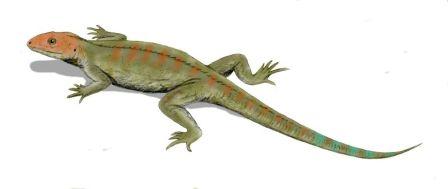
| Palaeos: Paleozoic |  |
Pennsylvanian Epoch |
| Carboniferous Period | Bashkirian Age |
| Page Back | Back: Serpukhovian | Back: Mississippian | Up: Pennsylvanian | Unit Home |
| Page Next | Next: Moscovian | Next: Cisuralian | Timecale |
The Bashkirian is in the ICS geologic timescale the lowest stage or oldest age of the Pennsylvanian, the youngest subsystem of the Carboniferous. The Bashkirian age lasted from 318.1 ± 1.3 to 311.7 ± 1.1 Ma, is preceded by the Serpukhovian and is followed by the Moscovian. The Bashkirian could be described as later Middle Carboniferous; the first of the four epochs that make up the Pennsylvanian subperiod.
At this time, the Euramerican tropics come to be dominated by great lowland swamps, characterized by lycophyte, sphenopsid, and medullosan plants, and inhabited by many types of invertebrates, stem tetrapods and the occasional primitive reptile. Meanwhile, Gondwana is covered by spreading ice sheets.
The Bear Gulch locality in Montana provides an important glimpse of Carboniferous fish life.
Polar Gondwana covered in ice. The great Coal Swamps (or mires) become an important biome.
Based on the stratotype of the Moscow Basin / Urals. Incorporates the Namurian B and C and Westpahlian A of the Western Europe.
Divided into five ages. The Marsdenian, Kinderscoutian, and Yeadonian are based on Namurian goniatite zones defined in the British Isles, and collectively make up the Early Bashkirian. The Chermshanskian and Melekesskian are part of the standard Russian sequence and are used to define the Late Bashkirian
Low lying tropical wetlands in Euramerica.
At this time the southern hemisphere, namely the supercontinent of Gondwana, became significantly glaciated. The paleo north pole also experienced glaciation though not as extensive as the south. This cooling trend started in the Serpukhovian as evidenced by the migration of marine invertibrates away from the paleo south pole (Isbell et al., 2003). As the poles became more frigid the equatorial regions became wetter and possibly warmer. Despite glaciation in Gondwana, the equatorial regions remain tropical.
The equatorial wetlands enable the rise of the great Carboniferous Coal Swamps (or mires). Important plants include Lepidophloios, Diaphorodendron, Paracyclopodites, Sigillaria, Calamites, Sphenophyllum, Psaronius, and Medullosa.
.Sudden appearance of winged insects of various kinds

Hylonomus lyelli, an early reptile from the Late Carboniferous of Nova Scotia, Canada. Life reconstruction by Nobu Tamura |
Chondrichthyes are diverse in seas, and current forms are joined by a new lineage, the Eugeneodontida. Osteichthyes are common in fresh water, and include both the Rhizodontiformes and the Osteolepiformes. In the ponds, rivers and swamps and on land stem tetrapods continue to constitute the majority of tetrapods. Amniotes made their appearance, with the oldest unquestionable reptile, Hylonomus, approximately 315 million years ago.
| Page Back | Unit Home | Page Up | Page Top | Page Next |